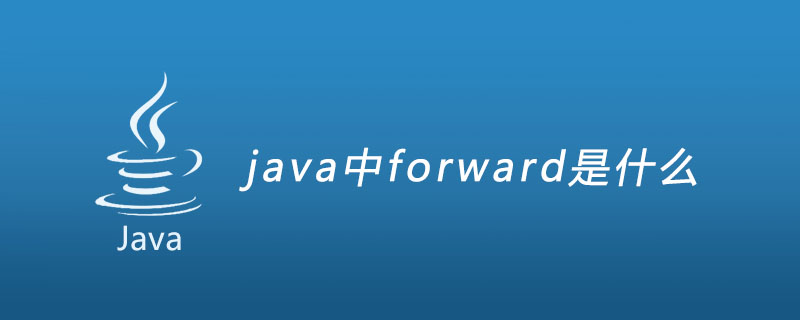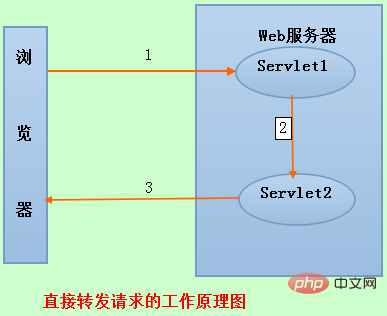Home >Java >javaTutorial >What is forward in java
What is forward in java
- (*-*)浩Original
- 2019-05-22 20:03:338591browse
In java, forward refers to "direct forwarding method". For the direct method, the client browser only issues a request. The Servlet forwards the request to Servlet, HTML, JSP or other information resources. The second information resource responds to the request. In the request object request, the saved object is for each Information resources are shared.

The user sends an HTTP request to the server. The request may be processed by multiple information resources before being returned to the user. Each information resource uses a request forwarding mechanism. Requests are forwarded to each other, but users do not feel that the requests are forwarded. Depending on the forwarding method, it can be divided into direct request forwarding (Forward) and indirect request forwarding (Redirect).
Direct forwarding method (Forward), the client and browser only issue one request. Servlet, HTML, JSP or other information resources, the second information resource responds to the request, and saves it in the request object request. The objects are shared with each information resource.
The indirect forwarding method (Redirect) is actually two HTTP requests. When the server responds to the first request, it allows the browser to send a request to another URL to achieve the purpose of forwarding.
To give a popular example:
Direct forwarding is equivalent to: "A asked B to borrow money, B said he didn't have it, B went to C to borrow it, and if he couldn't borrow it, he would pass the message on. To A";
Indirect forwarding is equivalent to: "A asked B to borrow money, but B said he didn't have it, so he asked A to borrow money from C."
Detailed explanation of the direct forwarding method (Forward)
The direct forwarding method is used more often. Generally speaking, request forwarding refers to the direct forwarding method. Most web applications will have a controller. It is up to the controller to control which information resource the request should be forwarded to. Then these information resources process the request, and after processing, it may be forwarded to other information resources to return to the user. This process is the classic MVC model.
javax.serlvet.RequestDispatcher interface is an interface that the request forwarder must implement. The Web container provides the Servlet with an object that implements this interface. The purpose of request forwarding is achieved by calling the forward() method of the interface. Example code As follows:
......
//Servlet里处理get请求的方法
public void doGet(HttpServletRequest request , HttpServletResponse response){
//获取请求转发器对象,该转发器的指向通过getRequestDisPatcher()的参数设置
RequestDispatcher requestDispatcher =request.getRequestDispatcher("资源的URL");
//调用forward()方法,转发请求
requestDispatcher.forward(request,response);
}......
The process of directly forwarding the request shown in the above figure is as follows:
The browser issues an access request to Servlet1;
Servlet1 calls the forward() method and forwards the request to Servlet2 on the server side;
Eventually Servlet2 responds.
Tips: In fact, through the browser, you can observe the request forwarding method used by the server. When a hyperlink is clicked, the current address bar will appear in the browser's address bar. The requested address. If after the server-side response is completed, it is found that the address in the address bar has changed, it proves that the request is forwarded indirectly. On the contrary, if the address does not change, it means a direct request for forwarding or no forwarding.
Extended information:
What are the principles and differences between direct forwarding and indirect forwarding?
Answer: Forward and Redirect represent two request forwarding methods: direct forwarding and indirect forwarding. Corresponding to the code, they are the forward() method of the RequestDispatcher class and the sendRedirect() method of the HttpServletRequest class.
For the indirect method, when the server responds to the first request, it allows the browser to send a request to another URL to achieve the purpose of forwarding. It is essentially two HTTP requests, corresponding to two request objects.
For the direct method, the client browser only issues one request, and the Servlet forwards the request to Servlet, HTML, JSP or other information resources. The second information resource responds to the request. The two information resources share the same A request object.
The above is the detailed content of What is forward in java. For more information, please follow other related articles on the PHP Chinese website!

